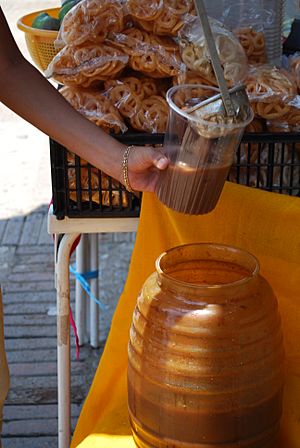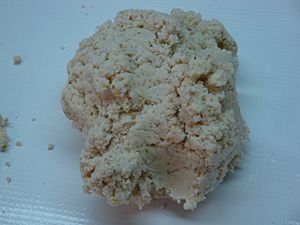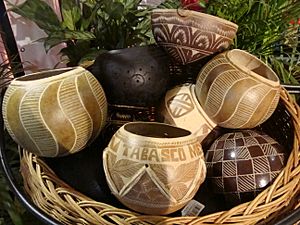Pozol facts for kids

Pozol being served at the boardwalk of Chiapa de Corzo, Chiapas
|
|
| Ingredients | corn dough |
|---|---|
Pozol is a special drink and food from Mexico. It comes from ancient times, even before Europeans arrived. The name "Pozol" comes from the Nahuatl language. It can be a fermented corn dough or a drink made from this dough mixed with cocoa. People in the southern Mexican states of Chiapas and Tabasco drink it a lot. It helps quench thirst and was even used as a traditional medicine. It also gave indigenous peoples energy for long journeys through the jungle.
The History of Pozol
Pozol has a long history! The Maya-Chontales from Belize first made this drink. They used boiled cornmeal, cocoa, and grains.
The drink was first called pochotl. This name came from the Nahuatl word "pozolli", which means "sparkling." When the Spanish arrived in Tabasco in 1519, the name changed to "pozol."
Traditionally, women made pozol by fermenting corn dough. This dough was then mixed with water and eaten. Many ethnic groups in southern Mexico enjoyed it. In Chiapas, the Mayans, Zoqueans, and Chiapanecos drank it.
People drink pozol all day long. In ancient times, it was mixed with cocoa and had no sugar. Since the 1900s, people in Chiapas started adding sugar and ice.
Pozol cornballs do not spoil easily. Because of this, different groups used them as food for long trips through the jungle. Besides being food, pozol was also used as medicine. It was also part of religious ceremonies. In the past, the Maya used pozol balls as a poultice. This helped prevent or treat skin infections and wounds.
Pozol also had a special ceremonial meaning. Before the Spanish arrived, it was an important part of offerings in Maya festivals. These festivals were often about growing and harvesting corn. Even today, the Maya people of the Yucatán Peninsula use pozol. They call it K'eyem and use it in their harvest rites.
How to Make Pozol
Pozol is made by fermenting corn dough. This dough is then shaped into balls or loaves. It can be kept fresh by wrapping it in banana leaves. To make the drink, you just soak the dough in water. It becomes a "whitish porridge." Sometimes, people add chili pepper, honey, or sugar.
There are different kinds of pozol. White pozol is made from dough mixed with water. It can be sweet or unsweetened. Some people in Tuxtla Gutierrez, Chiapas, like to make sour pozol. This dough is fermented for three days. It can be enjoyed with or without sugar. People often drink it cold with a pinch of salt and a slice of chili. Sometimes, they mix salt with chili powder.
Today, the Lacandones use pozol mixed with honey. They use it to help with fever and tummy troubles like diarrhea. This is similar to how some people use foods with yeast or lactobacillus.
You can also find pozol made with milk and horchata. The corn dough is mixed with milk instead of water, plus sugar. This makes a much sweeter version. In Tabasco, the most popular type is sweetened pozol with cocoa.
Pozol in Tabasco
In the State of Tabasco, pozol is a very traditional drink. In ancient times, people in Tabasco really valued pozol. They believed it helped them stay strong.
In 1579, the government of Tabasco officially said that pozol was a typical "tabasqueña" drink. They noted that the Chontal people often drank pozol instead of eating much. They also drank a cocoa drink.
Europeans who visited Tabasco saw that pozol helped the local people handle the hot, tropical weather.
In Tabasco, there are four main types of pozol:
- White pozol
- Black pozol
- Cacao Special pozol
- Sour pozol
In small towns, people often drink white pozol without sugar. Instead, they add salt and fresh amashito chili. Or they might have it with candied papaya called "Oreja de mico" (which means "monkey's ear").
Pozol is a very important part of Tabasco's culture. It is as special as the "Pocho" dance or the "caballito blanco."
In Villahermosa and all over Tabasco, you can easily find places to try pozol. There is a local saying: "A visitor who arrives to Tabasco and drinks pozol and likes it, takes up residence in Tabasco." This means if you like pozol, you'll love Tabasco!
Pozol in Chiapas
For some Native People in Chiapas, Pozol is almost like a special offering to their gods. Just like in Tabasco, the Mayans, Zoqueans, and Chiapanecos from this state have made this drink for ages. They use cooked corn and cacao.
Pozol is often enjoyed at midday. It helps calm both hunger and thirst. It's very healthy because it has amino acids, vitamins, and fiber. People sometimes eat a small snack with it, like a taco or empanada. If they drink the non-cacao version, they might bite on chili preserves. The cold, smooth corn drink helps cool down the spicy taste.
See also
 In Spanish: Pozol para niños
In Spanish: Pozol para niños




